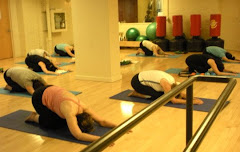Bartenieff Fundamentals (sm) are an extension of LMA originally developed by Irmgard Bartenieff, the Founder of the Laban/Bartenieff Institute of Movement Studies - LIMS NYC, who trained with Laban before moving to the USA and becoming a physiotherapist and one of the founding members of the American Dance Therapy Association.
Laban Movement Analysis is generally divided into these categories:Laban named the combination of (Space, Weight, and Time) the Effort Actions, or Action Drive.
Body (Bartenieff Fundamentals sm, total-body connectivity),
Space (Choreutics, Space Harmony)
Effort (Energetic dynamics),
Shape
Phrasing
Relationships
Then there are the following combinations:
Effort Factor Effort element (Fighting polarity)
Effort element (Indulging polarity)
Space Direct Indirect (Flexible)
Weight Strong Light
Time Sudden (quick) Sustained
Flow Bound Free
Movement combinations are descriptively named 1) Float, 2) Punch(Thrust), 3) Glide, 4) Slash, 5) Dab,6) Wring, 7) Flick, and 8) Press.
The Action Efforts have been used extensively in some acting schools, including ALRA, to train the ability to change quickly between physical manifestations of emotion.
Flow, on the other hand, is responsible for the continuousness or ongoingness of motions. Without any Flow Effort, movement must be contained in a single initiation and action, which is why there are specific names for the Flow-less Action configurations of Effort. In general it is very difficult to remove Flow from much movement, and so a full analysis of Effort will typically need to go beyond the Effort Actions.
One of Laban's primary contributions to Laban Movement Analysis (LMA) are his theories of Space. This category involves motion in connection with the environment, and with spatial patterns, pathways, and lines of spatial tension.
Laban described a complex system of geometry based on crystalline forms, Platonic solids, and the structure of the human body. He felt that there were ways of organizing and moving in space that were specifically harmonious, in the same sense as music can be harmonious. Some combinations and organizations were more theoretically and aesthetically pleasing. As with music, Space Harmony sometimes takes the form of set 'scales' of movement within geometric forms. These scales can be practiced in order to refine the range of movement and reveal individual movement preferences. The abstract and theoretical depth of this part of the system is often considered to be much greater than the rest of the system. In practical terms, there is much of the Space category that does not specifically contribute to the ideas of Space Harmony.
This category also describes and notates choices which refer specifically to space, paying attention to: Kinesphere: the area that the body is moving within and how the mover is paying attention to it. Spatial Intention: the directions or points in space that the mover is identifying or using.
I wonder how Laban's work applies to the Martial Arts and Katas (型 or 形 literally: "form") as well. I am not sure however, if these things should be considered along side each other. There were developed differently and are taught differently.
Other Readings, Resources http://www.labanguild.f9.co.uk/aboutUs.html Laban, R. (1975). Laban’s Principles of Dance and Movement Notation. 2nd edition edited and annotated by R. Lange. London: MacDonald and Evans. (First published 1956.) Laban, R. (1980). The Mastery of Movement. 4th edition revised and enlarged by L. Ullmann. London: MacDonald and Evans. (First published as The Mastery of Movement on the Stage, 1950.) Laban, R. (1984). A Vision of Dynamic Space. Compiled by L. Ullmann. London: The Falmer Press. Laban, R., and Lawrence, F. C. (1947) Effort. London: MacDonald and Evans. (4th reprint 1967). L











